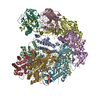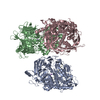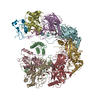[English] 日本語
 Yorodumi
Yorodumi- PDB-6w1x: Cryo-EM structure of anti-CRISPR AcrIF9, bound to the type I-F cr... -
+ Open data
Open data
- Basic information
Basic information
| Entry | Database: PDB / ID: 6w1x | ||||||||||||
|---|---|---|---|---|---|---|---|---|---|---|---|---|---|
| Title | Cryo-EM structure of anti-CRISPR AcrIF9, bound to the type I-F crRNA-guided CRISPR surveillance complex | ||||||||||||
 Components Components |
| ||||||||||||
 Keywords Keywords | IMMUNE SYSTEM/RNA / type I-F CRISPR RNA-guided surveillance complex / Csy complex / IMMUNE SYSTEM-RNA complex | ||||||||||||
| Function / homology |  Function and homology information Function and homology informationmaintenance of CRISPR repeat elements / endonuclease activity / defense response to virus / Hydrolases; Acting on ester bonds / RNA binding Similarity search - Function | ||||||||||||
| Biological species |   Proteus penneri (bacteria) Proteus penneri (bacteria) | ||||||||||||
| Method | ELECTRON MICROSCOPY / single particle reconstruction / cryo EM / Resolution: 3.9 Å | ||||||||||||
 Authors Authors | Hirschi, M. / Santiago-Frangos, A. / Wilkinson, R. / Golden, S.M. / Wiedenheft, B. / Lander, G. | ||||||||||||
| Funding support |  United States, 3items United States, 3items
| ||||||||||||
 Citation Citation |  Journal: Nat Commun / Year: 2020 Journal: Nat Commun / Year: 2020Title: AcrIF9 tethers non-sequence specific dsDNA to the CRISPR RNA-guided surveillance complex. Authors: Marscha Hirschi / Wang-Ting Lu / Andrew Santiago-Frangos / Royce Wilkinson / Sarah M Golden / Alan R Davidson / Gabriel C Lander / Blake Wiedenheft /   Abstract: Bacteria have evolved sophisticated adaptive immune systems, called CRISPR-Cas, that provide sequence-specific protection against phage infection. In turn, phages have evolved a broad spectrum of ...Bacteria have evolved sophisticated adaptive immune systems, called CRISPR-Cas, that provide sequence-specific protection against phage infection. In turn, phages have evolved a broad spectrum of anti-CRISPRs that suppress these immune systems. Here we report structures of anti-CRISPR protein IF9 (AcrIF9) in complex with the type I-F CRISPR RNA-guided surveillance complex (Csy). In addition to sterically blocking the hybridization of complementary dsDNA to the CRISPR RNA, our results show that AcrIF9 binding also promotes non-sequence-specific engagement with dsDNA, potentially sequestering the complex from target DNA. These findings highlight the versatility of anti-CRISPR mechanisms utilized by phages to suppress CRISPR-mediated immune systems. | ||||||||||||
| History |
|
- Structure visualization
Structure visualization
| Movie |
 Movie viewer Movie viewer |
|---|---|
| Structure viewer | Molecule:  Molmil Molmil Jmol/JSmol Jmol/JSmol |
- Downloads & links
Downloads & links
- Download
Download
| PDBx/mmCIF format |  6w1x.cif.gz 6w1x.cif.gz | 504 KB | Display |  PDBx/mmCIF format PDBx/mmCIF format |
|---|---|---|---|---|
| PDB format |  pdb6w1x.ent.gz pdb6w1x.ent.gz | 399.1 KB | Display |  PDB format PDB format |
| PDBx/mmJSON format |  6w1x.json.gz 6w1x.json.gz | Tree view |  PDBx/mmJSON format PDBx/mmJSON format | |
| Others |  Other downloads Other downloads |
-Validation report
| Summary document |  6w1x_validation.pdf.gz 6w1x_validation.pdf.gz | 1 MB | Display |  wwPDB validaton report wwPDB validaton report |
|---|---|---|---|---|
| Full document |  6w1x_full_validation.pdf.gz 6w1x_full_validation.pdf.gz | 1 MB | Display | |
| Data in XML |  6w1x_validation.xml.gz 6w1x_validation.xml.gz | 71.1 KB | Display | |
| Data in CIF |  6w1x_validation.cif.gz 6w1x_validation.cif.gz | 114.5 KB | Display | |
| Arichive directory |  https://data.pdbj.org/pub/pdb/validation_reports/w1/6w1x https://data.pdbj.org/pub/pdb/validation_reports/w1/6w1x ftp://data.pdbj.org/pub/pdb/validation_reports/w1/6w1x ftp://data.pdbj.org/pub/pdb/validation_reports/w1/6w1x | HTTPS FTP |
-Related structure data
| Related structure data |  21516MC  6whiC M: map data used to model this data C: citing same article ( |
|---|---|
| Similar structure data |
- Links
Links
- Assembly
Assembly
| Deposited unit | 
|
|---|---|
| 1 |
|
- Components
Components
-CRISPR-associated protein ... , 2 types, 7 molecules ACDEFGH
| #1: Protein | Mass: 49194.168 Da / Num. of mol.: 1 Source method: isolated from a genetically manipulated source Source: (gene. exp.)   |
|---|---|
| #3: Protein | Mass: 39778.594 Da / Num. of mol.: 6 Source method: isolated from a genetically manipulated source Source: (gene. exp.)   |
-Protein , 3 types, 4 molecules BLIJ
| #2: Protein | Mass: 36244.074 Da / Num. of mol.: 1 Source method: isolated from a genetically manipulated source Source: (gene. exp.)  Gene: csy2, ALP65_00953, EQH76_13810, FCG96_17775, PACL_0128 Production host:  |
|---|---|
| #5: Protein | Mass: 21427.504 Da / Num. of mol.: 1 Source method: isolated from a genetically manipulated source Source: (gene. exp.)   References: UniProt: Q02MM2, Hydrolases; Acting on ester bonds |
| #6: Protein | Mass: 7863.849 Da / Num. of mol.: 2 Source method: isolated from a genetically manipulated source Source: (gene. exp.)  Proteus penneri (bacteria) / Production host: Proteus penneri (bacteria) / Production host:  |
-RNA chain , 1 types, 1 molecules M
| #4: RNA chain | Mass: 19265.404 Da / Num. of mol.: 1 Source method: isolated from a genetically manipulated source Source: (gene. exp.)   |
|---|
-Experimental details
-Experiment
| Experiment | Method: ELECTRON MICROSCOPY |
|---|---|
| EM experiment | Aggregation state: PARTICLE / 3D reconstruction method: single particle reconstruction |
- Sample preparation
Sample preparation
| Component |
| ||||||||||||||||||||||||
|---|---|---|---|---|---|---|---|---|---|---|---|---|---|---|---|---|---|---|---|---|---|---|---|---|---|
| Source (natural) |
| ||||||||||||||||||||||||
| Source (recombinant) |
| ||||||||||||||||||||||||
| Buffer solution | pH: 7.5 | ||||||||||||||||||||||||
| Buffer component |
| ||||||||||||||||||||||||
| Specimen | Conc.: 2.5 mg/ml / Embedding applied: NO / Shadowing applied: NO / Staining applied: NO / Vitrification applied: YES | ||||||||||||||||||||||||
| Specimen support | Details: unspecified / Grid material: GOLD / Grid mesh size: 300 divisions/in. / Grid type: Quantifoil, UltrAuFoil, R1.2/1.3 | ||||||||||||||||||||||||
| Vitrification | Instrument: HOMEMADE PLUNGER / Cryogen name: ETHANE / Humidity: 95 % / Chamber temperature: 277 K |
- Electron microscopy imaging
Electron microscopy imaging
| Experimental equipment |  Model: Talos Arctica / Image courtesy: FEI Company |
|---|---|
| Microscopy | Model: FEI TALOS ARCTICA |
| Electron gun | Electron source:  FIELD EMISSION GUN / Accelerating voltage: 200 kV / Illumination mode: FLOOD BEAM FIELD EMISSION GUN / Accelerating voltage: 200 kV / Illumination mode: FLOOD BEAM |
| Electron lens | Mode: BRIGHT FIELD / Nominal magnification: 36000 X / Nominal defocus max: 1200 nm / Nominal defocus min: 800 nm / Cs: 2.7 mm / C2 aperture diameter: 100 µm / Alignment procedure: ZEMLIN TABLEAU |
| Specimen holder | Cryogen: NITROGEN |
| Image recording | Average exposure time: 13.2 sec. / Electron dose: 66 e/Å2 / Detector mode: COUNTING / Film or detector model: GATAN K2 SUMMIT (4k x 4k) / Num. of real images: 1653 |
| Image scans | Movie frames/image: 66 |
- Processing
Processing
| EM software | Name: Leginon / Category: image acquisition |
|---|---|
| CTF correction | Type: NONE |
| Particle selection | Num. of particles selected: 1571636 |
| Symmetry | Point symmetry: C1 (asymmetric) |
| 3D reconstruction | Resolution: 3.9 Å / Resolution method: FSC 0.143 CUT-OFF / Num. of particles: 285707 / Symmetry type: POINT |
 Movie
Movie Controller
Controller










 PDBj
PDBj





























